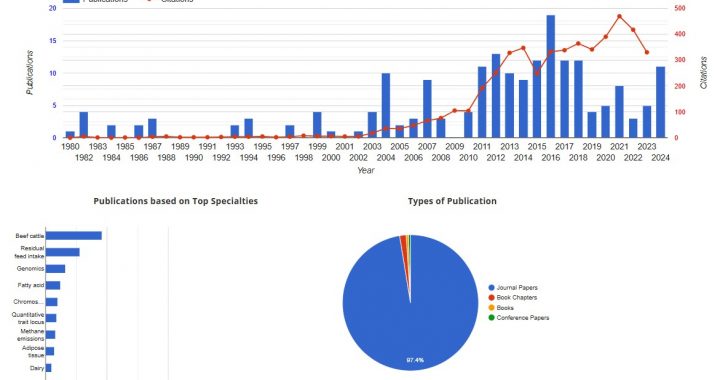Livestock Gentec strives for research excellence. To be excellent in research we need to be productive and impactful. Just as important, we need to associate with excellent collaborators. We cannot directly quantify excellence, but there are useful metrics to show productivity and impact of research. For example, many sources look at number of published papers, citations, and H-index. H-index is a measure of how many well-cited papers a researcher has published (ie a higher H-index means a researcher has more articles with a high number of citations). Researchers may be familiar with these metrics from various online scholar profiles services such as Google Scholar, ResearchGate and ScholarGPS. These indexing tools are not perfect, but do a good job at consolidating publications online. Researcher profiles on ScholarGPS includes ranks and percentiles based on these productivity and impact measures. In this article, we explore these online tools, their limitations and collaboration as a qualitative aspect of research excellence.
For fun, we looked at our team and collaborators to see how well we stack up in some very active research fields. Livestock Gentec leaders Dr. Graham Plastow and Dr. John Basarab, are both ranked in the top 1% of over 1-million scholars ranked in Agriculture and Natural Resources. When we start looking at their specialties, their ranks jump further. With Dr. John Basarab ranked 58 for over 16,000 beef cattle researchers in publication and Dr. Graham Plastow ranked 176 in over 370,000 genomics researchers. Many of our collaborators also hold leading ranks on ScholarGPS. Dr. Changxi Li, Research Scientist with Agriculture and Agri-Food Canada is in the top 1-percentile for publications in genomics. Dr. Tim McAllister, Research Scientist with Agriculture and AgriFood Canada is a top 100 researcher in Agriculture and Natural Resources for publications. Dr. Michael Dyck, Professor University of Alberta is in the top 1-percentile for transcriptomic publications. Dr. Carolyn Fitzsimmons, Research Scientist Agriculture Agri-Food Canada, is a top 1-percentile for Beef cattle publications as well. We have only highlighted a few, but going through this exercise, we appreciate how many of our partners contribute on a global-scale to their fields.
These metrics and ranks do not tell the full story of productivity. Seminal papers can drive the science forward, cementing their authors’ excellence, regardless of the metrics. Further, length of career will affect how these metrics as well. Adjusted H-index and alternative metrics exist to integrate those considerations. Another common limitation is indexing platforms can create multiple profiles for the same person, biasing against circumstances like changing institutions or names. Acknowledging these limitations, our high-ranking collaborators provide some validation.
We also want to raise the qualitative aspects of excellence in research. For example, sharing knowledge and experience are key to good science. In a healthy scholarly environment, diversity in thought improves ideas. Collaborations also facilitate added capacity through synergies and scale. Excellence in collaboration may be difficult to quantify, but the approach takes an effort worth recognizing. To ground this in an anecdote, Dr. Plastow and Dr. Basarab are involved in an application for Horizon 2025 with a European and Canadian livestock research consortium. This consortium includes researchers from Belgium, France, Netherlands, Denmark, and Canada. One aim in the proposed project is to develop and implement Near Infrared Spectroscopy (NIRS) fecal scans as a proxy measure for enteric methane emissions from beef cattle. Dr. Basarab is PI on collaborative project: “Reducing Greenhouse Gas Emissions from the Canadian Beef Industry through the Development and Adoption of Genomic Tools” awarded through a NSERC-SSHRC Alliance Grant for sustainable agriculture. This project is well aligned with the new European project as fecal NIRS is proceeding using samples collected from five research sites across Canada. If the application to Horizon 2025 is successful, we will greatly expand our capabilities in both projects to achieve the goal of developing a scalable enteric GHG proxy measure from faecal NIRS in beef cattle.
Metrics have their utility but are not comprehensive in defining excellence in research. Impactful research drives science forward and collaboration is one of our best tools. As such, Livestock Gentec focuses on impactful research and facilitating collaborations to achieve excellence in research. Livestock Gentec’s strategic-framework defines three focuses: excellence in local and applied research; excellence in global research collaboration; and excellence in recruitment, training and placement of highly qualified personnel. Our International Industry and Scientific Committee in its 2022 report summary highlighted the continued need to focus on participatory research and “develop a formalized strategy of integrating current students into industry” (see our strategic framework here). These perspectives challenge us to take a broad-view of research and collaboration success to achieve progress in industry and science.


